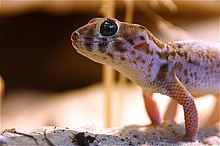Wonder gecko
| Wonder gecko | ||||||||||||
|---|---|---|---|---|---|---|---|---|---|---|---|---|

Wonder gecko ( Teratoscincus scincus ) |
||||||||||||
| Systematics | ||||||||||||
|
||||||||||||
| Scientific name | ||||||||||||
| Teratoscincus scincus | ||||||||||||
| ( Schlegel , 1858) |
The wonder gecko ( Teratoscincus scincus ) is a lizard from the order of the gecko-like (Gekkota).
features
The wonder gecko can reach a total length of 18 to 20 centimeters, but usually remains smaller. The basic color is a camouflage color and varies between light yellow and yellow. The back is covered with brown to black patterns. The tail is gray and also has large scales. The rather powerful and broad head has two very large eyes that are adapted to its night activity. The tail has several predetermined breaking points and can be thrown off in case of danger. It grows back completely. The same applies to its easily removable skin flakes. The genders are very difficult to distinguish externally. Only the slight swellings of the hemipenic pockets reveal the gender. In the cold season, the wonder gecko hibernates for several months. The animals can reach an age of up to 13 years.
Subspecies
There are three subspecies:
- Great wonder gecko ( Teratoscincus scincus keyserlingii )
- Blue wonder gecko ( Teratoscincus scincus scincus )
- Teratoscincus scincus rustamowi
Distribution and way of life
The distribution area extends from Iran over the east coast of the Caspian Sea to western China. It is also found in Afghanistan, northwest Pakistan and on the Arabian Peninsula on the coasts of Qatar and the United Arab Emirates . It inhabits deserts and semi-deserts with sparse vegetation.
food
Wonder geckos feed mainly on small insects . Here and there they improve their diet with fruits and berries.
Reproduction
Wonder geckos belong to the egg-laying reptiles. The mating season begins after hibernation. The female lays two hard-shelled eggs up to four times per season, which she buries in the sand with her hind legs or simply leaves in their hiding place. The eggs weigh between 2.5 and 3 g, are between 17 and 21 mm long and almost always have a characteristic dent. The young hatched in captivity at a temperature of 25 to 31 ° C after 65 to 75 days. They are then 62 to 70 mm long, colored conspicuously yellow with black cross bars and weigh 1.58 to 1.89 g. The lizards reach the size of the adult animals within a year
literature
- Manfred Rogner : Lizards. Volume 1: geckos, pinnipeds, agamas, chameleons and iguanas. Ulmer, Stuttgart 1992, ISBN 3-8001-7248-8 .
